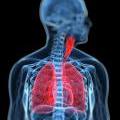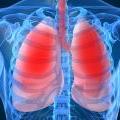Contents
- What is mesothelioma?
- How does mesothelioma develop?
- How is mesothelioma diagnosed?
- What role does surgery play in the treatment of mesothelioma?
- Diagnostic and palliative surgery for treating mesothelioma
- Radical surgery for mesothelioma
What is mesothelioma?
Malignant mesothelioma is a cancer of the lining of the chest wall and of the lung. It is usually caused by exposure to asbestos, even for a short period of time, and it occurs many years (even 30 or 40) after the initial exposure.
Asbestos is a natural fibrous mineral that is widely distributed in nature and because of its fire and heat resistant properties was extensively used in the automotive, shipping and building industries. It is asbestos dust or airborne fibres that cause harm when inhaled or ingested. Asbestos fibres are very fine and if they are breathed in they can reach the smallest areas of the  lung where they cannot be breathed or coughed out. Once they have lodged in the lung the fibres can also penetrate the edge of the lung and settle in the pleural lining. It is still not understood why mesothelioma starts to grow on the lining of the chest wall even if it comes from the lung.
lung where they cannot be breathed or coughed out. Once they have lodged in the lung the fibres can also penetrate the edge of the lung and settle in the pleural lining. It is still not understood why mesothelioma starts to grow on the lining of the chest wall even if it comes from the lung.
How does mesothelioma develop?
At the beginning there might be only a small lump inside the chest, which is undetectable on normal diagnostic scans. Over time patients might develop general symptoms of tiredness and weight loss. Shortness of breath is also possible due to accumulation of fluid between the lung and the chest wall. The result is that the lung is compressed by the fluid and so cannot work as well as it should, and the result is that most patients experience a progressive reduction in their ability to tolerate exercise. When the cancer starts to invade the nerves and bones in the chest some patients also experience pain either in the chest or radiated to the arms. The appearance of a cough and changes in the voice are also possible.
How is mesothelioma diagnosed?
It is not easy to diagnose mesothelioma. Your doctor will request a CT scan of the chest and possibly an MRI or PET scan. Sometimes some fluid will be aspirated from the chest and sent for cytological examination. While these tests provide a very good indication of the pathological process affecting the chest, certainty of the diagnosis can only be reached with a surgical biopsy.
What role does surgery play in the treatment of mesothelioma?
Surgery can play an important role in the treatment of malignant mesothelioma in confirming the diagnosis, assessing the spread of the tumour (stage) and in the control of symptoms. In some cases surgery can also help to increase length of life and in this case your surgeon will refer to it as radical surgery.
Diagnostic and palliative surgery for treating mesothelioma
Surgery is often necessary in order to gain a proper diagnosis for mesothelioma. This procedure allows the chest cavity to be thoroughly inspected, any fluid that may be present to be evacuated and large biopsies to be taken, which can increase the chances of getting a firm diagnosis. Thoracic surgeons can perform this surgery as a minimally invasive keyhole procedure under general anesthetic. If the surgeon suspects at the time of the biopsy that there is malignancy, it is possible to blow some talcum powder into the chest cavity. This acts like glue and in most cases it will stop the fluid from coming back. If there is an extensive malignant process and the lung is not fully re-expanding after the fluid is aspirated then it is not possible to put talcum powder in. Instead your surgeon will put in a small soft tube so that the fluid can be drained by a nurse at home.
If radical surgery is contemplated then it is necessary to assess the status of the lymph nodes in the middle of the chest. This can be done as a day case procedure that is called mediastinoscopy. A small camera is inserted in front of the main wind pipe (trachea) through a 3 cm incision above the breast bone. Biopsies of all the glands are then taken. The procedure is not painful and usually it is possible to go home on the same day.
Radical surgery for mesothelioma
The intention of radical surgery is to remove all or the majority of the visible tumour. This is not always possible as mesothelioma is a coating disease, unlike lung cancer, which grows in a lump. In the case of mesothelioma, patients are unfortunately not cured by radical surgery although in selected patients there is a potential benefit. Surgery alone is never enough and therefore it is always combined with chemotherapy or chemo-radiotherapy.

There are two radical surgical options for mesothelioma and these are extra-pleural pneumonectomy (EPP) and radical pleurectomy and decortication (P/D). EPP is designed to remove the tumour with the lung, the pericardium (the bag where the heart lives) and the diaphragm. This is now only performed outside the UK. There is some evidence that shows that the procedure is more toxic than the disease that it is intended to fight. EPP is a very morbid operation and it is not easily tolerated.
The aim of P/D is to remove all of the visible disease from within the chest, including the pericardium and diaphragm if necessary, but sparing the lung. Preserving the lung will greatly reduce the chances of death and it is a much better tolerated procedure. The recovery is usually faster and allows a more timely access to chemo-radiotherapy. Some evidence shows that there isn’t much difference between EPP and P/D.
In conclusion then, surgery is frequently used across the UK in order to be able to make a diagnosis and to treat a build-up of fluid in the lung. However, only a few specialist surgeons and hospitals have the resources and expertise to treat radically malignant mesothelioma. It is advisable that you ask for a referral to discuss your case with a specialist team.
